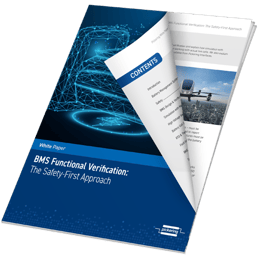Many of the tests required to verify battery management systems (BMS) are too dangerous to conduct in real life as the conditions could result in fire, explosion, or damaging the unit under test.
In this white paper, we explore the importance of BMS simulation and specifically how hardware-in-the-loop (HIL) offers a safe BMS testing environment, comprehensive testing capabilities, replication of real-world conditions including state-of-charge (SoC) and state-of-health (SoH) functional verification, flexibility, scalability, and time and cost savings.
You will learn:
- Top-level functional requirements of BMS verification include voltage, current flow, SoC & SoH monitoring, and thermal management.
- How to create a comprehensive BMS HIL test environment that will provide valuable data, save time, and ensure safety.
- The safest way to verify your system using BMS fault testing and simulation.
- Why HIL simulation is key to success regarding safety and repeatability.
- Which HIL switching and simulation modules will help you achieve your BMS verification goals.
Submit the form to get your free copy of "BMS Functional Verification: The Safety-First Approach."
Topics covered in the paper encompass BMS Hardware-in-the-Loop Testing, including battery cell simulation, fault insertion switching, charge emulation, COMMS, load emulation, temp sensor simulation, and isolation resistance simulation.




